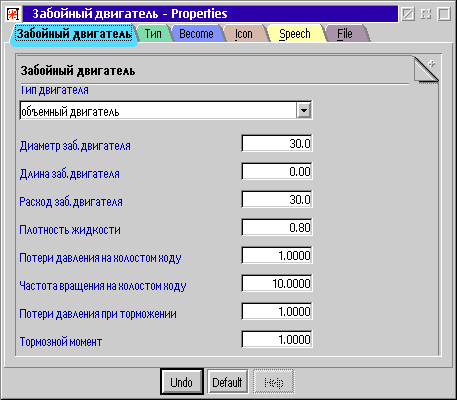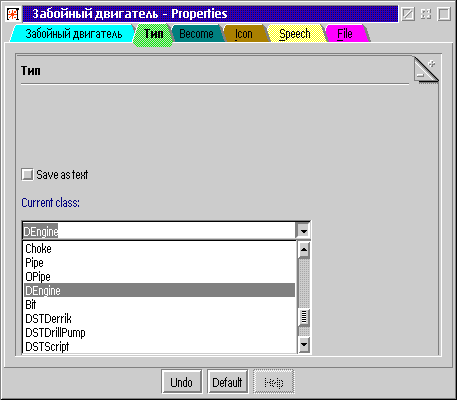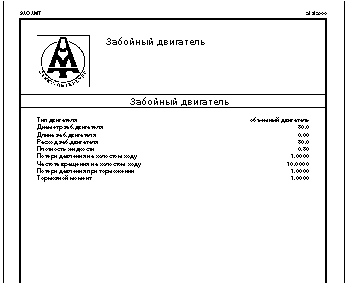|
|

|
AD: ArcaOS 5.1 Russian LIP
Russian ARCAOS exists and it's available since the middle of 2017.
All versions are supported: 5.1, 5.1.1.
eCo Software is able to maintain OS/2 LIP packages for any other language
(German, Dutch, Brazilian Portuguese, Spanish, Sweden, etc)
|
Using XObject for Configuration Files |
TITLE: Using XObject for Configuration Files
DATE: 2010-09-28 11:11:45
AUTHOR: Joseph Shrago
Preface
This report covers certain aspects of working with configuration files
(ini-files, profiles, registry, etc). Against the background of
common ways of organizing such files, we’ll review the language
for informational (non-executable) objects description (as well as
its OS/2 API), that has been developed for specific task (drilling
training simulator for OS/2), but is pretty universal.
The
most primitive description method "parameter"="value"
is commonly used and well known.
CONFIG.SYS
file is a good example:
SET
EPMPATH=C:\OS2\APPS;C:\opendoc\BIN;
PROTECTONLY=NO
SHELL=C:\OS2\MDOS\COMMAND.COM
C:\OS2\MDOS
FCBS=16,8
RMSIZE=640
DEVICE=C:\OS2\MDOS\VEMM.SYS
DOS=LOW,NOUMB
DEVICE=C:\OS2\MDOS\VXMS.SYS
/UMB
DEVICE=C:\OS2\MDOS\VDPMI.SYS
DEVICE=C:\OS2\MDOS\VDPX.SYS
DEVICE=C:\OS2\MDOS\VWIN.SYS
DEVICE=C:\OS2\MDOS\VW32S.SYS
This
method has a drawback: there's no way to syntactically separate
different objects' descriptions within one file. Still, it's easy to
implement and in many cases suitable. But not always possible.
Windows
ini-files (Windows 3.11) introduced a slight improvement: sections.
Named sections allow using structured descriptions and query
description elements using two parameters "section
name"-"parameter name", which is more convenient.
Here's
an example from SYSTEM.INI file for WIN-OS2 session:
[keyboard]
subtype=
type=4
keyboard.dll=kbdru.dll
oemansi.bin=xlat866.bin
typeofswitch=2
secondkeyb.dll=kbdusx.dll
[boot.description]
keyboard.typ=Enhanced
101 or 102 key US and Non US keyboards
mouse.drv=Microsoft,
or IBM PS/2
network.drv=No
Network Installed
language.dll=Russian
system.drv=MS-DOS
System
codepage=866
woafont.fon=Russian
(866)
The
disadvantages here are: syntactical indifference when dealing with
variable number of entries within one section, and no nesting for
section (which may be useful, since not all informational objects are
linear). Of course, this may be implemented, but particular
implementation will be a developer's quick wit, rather than the
result of syntactical structure.
The
next step in the evolution of description scripts is registry
(Windows 9x or higher), and OS/2 ini-files. Both allow tree structure
(nesting) and storing objects of any type by using binary objects
(defined by those who use them).
To
criticize existing implementations of such resource (it’s
WINPRF.DLL in OS/2), we have to take into account requirements to the
configuration files syntax in general.
As
mentioned before, the views expressed here are the result of working
on scenario maintenance subsystem for drilling training simulator. A
scenario for such training simulator contains all parameters, that
define the initial state of the drill and borehole. It describes
numerous independent parameters — hardware descriptors, rock
and geological section descriptors as well as possible anomalies,
scattered all over the borehole (to entertain the trainee) etc.
The
scenarios are to be created by the end users of the product.
Therefore the descriptions and tools to create them have to be
intuitive enough for non-programmer to use. Since the same hardware
descriptions may be used in many scenarios, they has to be defined
separately and linked from within the scenario. There are means
provided for printing scenarios in good-looking readable form, to use
them as operating instructions.
These
requirements resulted the creation of informationally associated
software tools:
- WPS-objects
of each scenario object (hardware elements, geology etc);
- WPS-objects
for each type of technological tasks scenarios (hardware is
different, which means configuration dialogs, too);
- software
module for extracting specific data from scenario and passing it as
filled-in structure to the task-imitator.
Change
in the description of any object required correcting the software
implementation of interconnected objects, which is not very
convenient. This problem became obvious when developers have realized
that simplifying a number of descriptions was a mistake and it would
be nice to complement them.
Problems
described above serve as a good criticism when it comes to using
Profile API for maintaining complex configurations.
So
we’ve defined the following requirements to configuring
concept:
- object oriented
approach;
- text as well as
binary form, regardless of how configurations are used;
- there must be a
dialog for editing the configuration, or a possibility to edit it in
the text editor;
- configuration must
print itself;
- a possibility for
configuration to operate the data stored in other files.
These
requirements are fulfilled in our configuration files subsystem. It
offers syntax, base objects, WPS-object for visualization and
printing and an API for their software-based writing and reading.
Informal
Description:
Any
configuration file is rendered as a number of fields of certain
types. Types are either simple or compound. Thus, configuration file
itself is an object of a certain compound type (class).
A
syntax we offer for describing such classes operates with keywords,
literals and comments.
Literals
are identical to ones in C++ : \xx,
\\, \n,
\t and special %
literals.
Comments
are defined by symbols //,
/*, */
and used same way as in C++.
The
system deals with the following objects:
| classifier |
transient |
taken from class
as a default value; can be changed in any representative |
| base data types |
int
double
string
group |
integer
(4 bytes)
double (8 bytes)
string of symbols (doesn’t have
to be limited with \0)
arbitrary objects array: allows
accessing by element’s number
|
| base data types for
visualization and
printing |
IntField
DoubleField
StringField
TextField
RadioToggleField
CheckBoxField
ComboTogleField
ReferenceField
PasswordField |
editable and printable int class
editable and printable double class
editable and printable string class
editable and printable textarea class
in-dialog selection class using
RadioButton
in-dialog selection class using
CheckBox
in-dialog from-list-selection class
using ComboBox
link-class, in the dialog edited by
drag&drop
class for inputing and storing a
password, encoded with GOST 21847-89 |
| list type |
ObjectListField |
class for
storing reference elements of arbitraty type |
|
namedgroup |
based upon group; used to
describe dialog and printing |
Objects'
Description:
IntField
= {
string
title = "" // name, displayed in the edit dialog
or when printing
int
value = 0 // field value
int
min = 0 // minimum available integer value
int
max = 0 // maximum available integer value
int
delta = 0 // auto-change pitch in the edit dialog
}
DoubleField
= {
string
title = "" // name, displayed in the edit dialog or when printing
double
value = 0 // field value
double
min = 0 // minimum available double value
double
max = 0 // maximum available double value
double
coef = 0 // conversion factor (useful when editing certain
//
units of measuring, and using other)
double
delta = 0 // auto-change pitch in the edit dialog
int
decimals = 0 // number of symbols after decimal point,
//
displayed when editing and printing
}
StringField
= {
int
max = 0 // maximum number of symbols in line
string
title = "" // name, displayed in the edit dialog or when printing
string
value = "" // if the line is limited
by \0 line
delimiter
//
with single quotes '...' don't limited by
\0
}
TextField
= { // same as StringField, but is textarea (MLE)
int
max = 0
string
title = ""
string
value = ""
}
RadioToggleField
= { // implementation of dialog element
string
title = ""
int
value = 0 // contains the number of selected line
group
elements = { } // array of "string" type strings
}
CheckBoxField
= { // implementation of dialog element
string
title = ""
int
value = 0 // contains 1 if the element is selected
}
ComboToggleField
= { // same as above for ComboBox object
string
title = ""
int
value = 0
group
elements = { }
}
ReferenceField
class allows using multiple settings in one if, for example, software
product consists of multiple tasks, and each has own configuration
with individual and shared part. And vice versa, if the settings of
one object are used by many others.
ReferenceField
= { // object-reference to other object. drag&drop in the // dialog
string
title = ""
string
class = "" // name of the class of the objects of which may
fill this field
//
(multiple are possible - class0|class1|...)
string
value = "" // full path to file that contains object
int
value2 = 0 // WPS-objectid
}
ObjectListField class
allows creating lists of reference objects if, for example, list of
persons in the group or list of different network connections has
specific settings.
ObjectListField
list = { // example of object list
//
ReferenceField of a certain class
transient
string title = ""
transient
group factory = {
ReferenceField
rs = {
transient
string title = ""
transient
group menu = {
"Open"
"Close"
}
transient
string class = ""
string
value = ''
int
value2 = 0
}
}
transient
group buttons = {
"Add"
"Delete"
}
group
elements = {
}
}
When
displaying dialog ObjectListField in the list there are values of
element "string title" objects' descriptions, or value of
element "name|value", is there's StringField name element
in the description of reference object.
Access to a password,
set in PasswordField, is provided by exported function:
rc=getPasswordFieldValue(*XObject,password,sizeof(password));
To describe rock
images, we've implemented filling mask class:
ColorMaskField
= {
string
title = ""
int
fcolor = 0 // foreground color
int
bcolor = 0 // background color
int
width = 16 // width, points
int
height = 16 // height, points
string
value = '' // filling mask width*height
}
Some
data is predefined:
- title — by
default, contains string-name of the element, which is used in the
dialog and when printing;
- status — for
writing SUBTITLE string of the dialog page;
- value — by
default, contains element value;
- elements — used
to describe dialog and when printing;
- pages —
describes dialog page;
- sections —
describes script printing section.
Using
these types it is easy to create own description classes.
For
example, that's how class definition of the bottom-hole engine
description looks like (on russian):
DEngine
drill={
string
title="Забойный двигатель"
DoubleField
diam_zd ={ title="Диаметр заб.двигателя" coef=0.001
decimals=1 delta=0.1 min=30 max=400}
DoubleField
leng_zd ={ title="Длина заб.двигателя" coef=1 decimals=2
delta=0.01 max=50}
DoubleField
q_zd ={ title="Расход заб.двигателя" coef=1000
decimals=1 delta=0.1 min=30 max=400}
DoubleField
dens_zd ={ title="Плотность жидкости" coef=1000
decimals=2 delta=0.01 min=0.8 max=2.5}
DoubleField
loss_px_zd ={ title="Потери давления на холостом ходу"
coef=98100 min=1 max=200}
DoubleField
freq_nx_zd ={ title="Частота вращения на холостом ходу"
coef=0.01666 min=10 max=999}
DoubleField
loss_pt_zd ={ title="Потери давления при торможении"
coef=98100 min=1 max=200}
DoubleField
moment_t_zd={ title="Тормозной момент" coef=10 min=1
max=1500}
ComboToggleField
drop ={
string
title ="Тип двигателя"
group
elements = {
string
= "турбобур с постоянной линией"
string
= "турбобур с падающей линией"
string
= "объемный двигатель"
}
}
}
And
that's the description for specific bottom-hole engine (/* comment */
in the first line is needed to interpret text as XObject):
/*
XObject */
DEngine
= {
diam_zd
= {value = 30.0000}
leng_zd
= {value = 0.0000}
q_zd
= {value = 30.0000}
dens_zd
= {value = 0.8000}
loss_px_zd
= {value = 1.0000}
freq_nx_zd
= {value = 10.0000}
loss_pt_zd
= {value = 1.0000}
moment_t_zd
= {value = 1.0000}
drop
= {value = 0}
}
This
syntax demonstrates the possibility to make changes to each object
and additional fields: min, max etc.
Visualization
Let's
take a look at the visualization and printing we've mentioned before.
We've
created WPS-object that renders specifically organized parts of class
descriptions as its property pages. To do so, we add special
descriptors to class description: "group" with names
"pages" (for dialog) and "sections" for printing.
Here's
a part of the class that describes the dialog:
group
pages = {
namedgroup
= { // dialog page description
title
= "%MajorTab" // symbol % means MajorTab
status = "Subtitle"
elements
= {
string
= "name 1" // element of the class
string
= "name 2"
...
string
= "name N"
}
}
namedgroup
= { // second page of the dialog
title
= "MinorTab pages"
status = "Subtitle"
elements
= {
string
= "name 1"
string
= "name 2"
...
string
= "name N"
}
}
... //
other pages of the dialog
}
This
is
the part of description of bottom-hole engine (DEngine) class that
refers to dialog and it's result:
|
DEngine
drill={
...
group
pages = {
namedgroup
= {
string
title = "%Забойный двигатель"
string status = ""
group
elements = {
string = "drop"
string = "diam_zd"
string = "leng_zd"
string = "q_zd"
string = "dens_zd"
string = "loss_px_zd"
string = "freq_nx_zd"
string = "loss_pt_zd"
string = "moment_t_zd"
}
}
}
}
|
 |
Note
the second tab — "Type". It is always created and
allows choosing way (text/binary) of saving. The last one allows
easily edit any field of object using text editor. And vice versa,
any object may be created in the text editor and then saved as
binary. When saving in binary, object saves only differences from
base description. The other elements of description are inherited,
that's why the size of binary XObject file is much less than the
text one.

To
describe object printing we use similarly organized group sections,
and that's what we get when printing:
|
DEngine
drill={
...
group
sections={
namedgroup={
title
= "Забойный двигатель"
elements={
string
="drop"
string
="diam_zd"
string
="leng_zd"
string
="q_zd"
string
="dens_zd"
string
="loss_px_zd"
string
="freq_nx_zd"
string
="loss_pt_zd"
string
="moment_t_zd"
}
}
}
}
|
 |
To
print the object use the menu, or simply drag its icon onto printer's
icon (folder). Here's the example output after printing one object.
The same object, as ReferenceField inside the scenario, looks as
follows:
Usage:
To use
this configuring system, in the root or in the AMT_PATH environment
variable directory one has to create file config.ini of the following
content (we use our training simulator configuration as an example
here):
/*
AMT */
group
Config = {
string
customer = "Customer Corp" // for (C)Copyright printout
int
loglevel =
0
// -1 full debug output to \xobject.log
//
0 no error messages output
//
1 output warnings and error messages
group
classes = {
string =
"common.ini" // description of the common classes
string =
"DSTclass.ini" // drilling training simulator classes description
string =
"KRSclass.ini" // borehole extensive repairs training simulator
classes description
}
}
This
file is used by WPS-object AMTWPSXObject that implements dialogs and
configuration objects printing. This object is associated with AMT
extension.
Copy
all XObject support dynamic libraries into LIBPATH available in
environment variable. And using this Rexx script, perform the
registration:
/*********************************************************************/
/*
XObject registration utility */
/*********************************************************************/
Call
RxFuncAdd 'SysLoadFuncs', 'REXXUTIL', 'SysLoadFuncs'
Call
SysLoadFuncs
Say
'AMT XObjects to be registered'
rc=SysRegisterObjectClass('AMTWpsObject',
'amtwpso')
if
rc then say 'AMTWpsObject registered'
else
say 'AMTWpsObject cannot be registered'
Programming
using API XObject
When
programming, it is required to read descriptions of used classes -
for example, all config.ini and all files mentioned there, or only
required for specific task. The following text gives and example of
reading all classes libraries, described in config.ini:
#include
"common.h"
XObject *o_config; // for the script
//
function initializes XObject predefined classes subsystem
//
and returns number of classes in the library
int
InitXClasses(void)
{
char
buf[256]="", *str;
char
*amtPath = getenv(AMT_PATH);
int
num=0;
XOBJECT_INITIALIZE
//
loading classes libraries
buf[0]
= 0;
if
(amtPath) strcat(buf, amtPath);
strcat(buf,
"\\");
strcat(buf,
AMT_CONFIG);
o_config
= XObject::loadObject(buf);
if
(!o_config)
return 0;
o_config
= o_config->getGroupElement("classes");
for
(int i = 0; igetGroupSize(); i++ )
{
str
= o_config->getGroupElement(i)->getStringValue();
if
(str)
{
buf[0]
= 0;
if
(amtPath)
strcat(buf,
amtPath);
strcat(buf,
"\\");
strcat(buf, str);
num
+= XObject::loadClasses(buf);
}
}
return
num;
}
The
following lines represent the idea of getting certain class elements
of training simulator scenario:
{
...
o_main=XObject::loadObject(file_name);
//
loading required scenario file
if
(!o_main)
return
1;
//
error reading scenario - running in the test mode
...
o_sub
= o_main->getGroupElement("title");
Name=strdup(o_sub->getStringValue());
o_sub
= o_main->getGroupElement("model_type");
model_type=o_sub->getIntValue();
//
training simulator model type (number)
o_sub
= o_main->getGroupElement2("mode|value"); // using
compound name here
mode=o_sub->getIntValue();
//
training simulator model type (number)
//
if the element is link, using method GetValue(name),
//
it will load link script
o_ref=o_main->getValue("derrik");
// load drill description
//
or, in such a way
//
o_ref=XObject::loadObject(o_main->getGroupElement2("derrik|value")->getStringValue();
//
calculate g_kv parameter value using CI units of measurement
g_kv=o_ref->getGroupElement2("g_kv|value")->getDoubleValue()
* o_ref->getGroupElement2("g_kv|coef")->getDoubleValue();
}
The
configuration elements (parameters) can be accessed by class fields
names (name), compound names ("name|subname"), and also by
their sequence number in the group. In the above description of the
bottom-hole engine, the value can be taken from the name
<%1|value>,
since diam_zd has sequence number 1 in the class.
XObject
methods also allow saving information, obtained by software. This
simplifies visualization, printing and maintenance.
The
code below is the description of XObject class public objects:
class
_Export XObject {
public:
static
void setLogLevel(int);
static
int log(char*, ...);
static
int log(int, char*, ...);
static
int logObject(XObject*, char* = NULL);
static
void logClasses();
static
void initClass();
static
void unInitClass();
static
int loadFile(char*, char**, int*);
static
int saveFile(char*, char*, int);
static
XObject* getInstance(char*, char*, int = FLAGS_NORMAL, int =-1);
static
XObject* getInstanceText(char*, int*, int =-1);
static
XObject* getInstanceBin(char*, int*, int = -1);
static
int loadClasses(char*);
static
XObject* loadObject(char*);
static
int saveObject(char*, XObject*);
...
public:
static
int getClassNum();
static
char* getClassName(int);
...
public:
virtual
~XObject();
int isVoid();
int isInteger();
int isDouble();
int isString();
int isComplex();
int isGroup();
int isObject();
int isObject(char*);
int isBasic();
virtual
XObject* clone();
int initFrom(XObject*);
char* getName();
int setName(char* n);
char* getClassName();
int getClassVersion();
int getFlags();
int setFlags(int);
void flagSet(int);
void flagClear(int);
int flagIsSet(int);
int getSizeBin();
int getSizeText();
int getIntValue();
int setIntValue(int);
double getDoubleValue();
int setDoubleValue(double);
char* getStringValue();
int getStringSize();
int getStringLength();
int setStringSize(int);
int setStringValue(int, char*);
int setStringValue(char*);
int getGroupSize();
XObject* getGroupElement(int);
XObject* getGroupElement(char*);
XObject* getGroupElement2(char*);
int addGroupElement(XObject*);
int removeGroupElement(int);
int removeGroup();
int loadBinFile(char*);
int readText(char*, int);
int readBin(char*, int);
int writeBin(char*, int);
int writeText(char*, int, int = 0);
virtual
XObject* getValue();
virtual
int show(int);
virtual
int print(int);
virtual
int html(int);
//
misc
static
char* strPrintInteger(char*, int, int);
static
char* strPrintDouble(char*, double, int, int);
static
char* strPrintString(char*, char*, int, int*);
static
char* strPrintStringEsc(char*, char*, int, int*);
...
};
|
Test the program:
|
 Upgrade eComStation 2.0 desktop to NeoWPS (useful extenders for desktop)
Upgrade eComStation 2.0 desktop to NeoWPS (useful extenders for desktop)
|
Comments: Comment this article.

|
eComStation 2.0 can (automatically) switch between WiFi and Ethernet without headache. eCS 2.0 what's new? |
|
|





